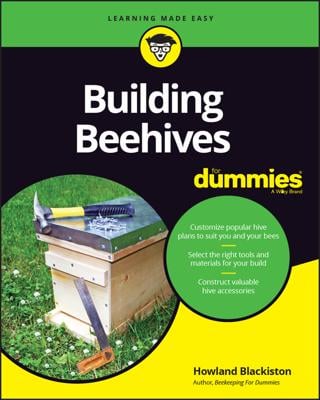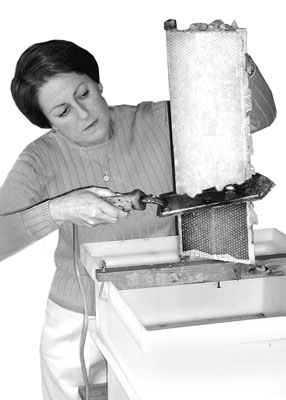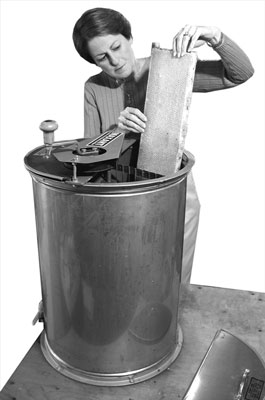Harvesting honey using an extractor
Follow this procedure when extracting honey from your Langstroth-style frames:- One by one, remove each frame of capped honey from the super.
Hold the frame vertically over the double uncapping tank and tip it slightly forward. This helps the cappings fall away from the comb as you slice them.
- Use your electric uncapping knife to remove the wax cappings and expose the cells of honey. A gentle side-to-side slicing motion works best, like slicing bread. Start a quarter of the way from the bottom of the comb, slicing upward (see the figure). Keep your fingers out of harm's way in the event the knife slips. Complete the job with a downward thrust of the knife to uncap the cells on the lower 25 percent of the frame.
- Use an uncapping fork (also called a cappings scratcher) to get any cells missed by the knife. Flip the frame over, and use the same technique to do the opposite side.
- When the frame is uncapped, place it vertically in your extractor.
An extractor is a device that spins the honey from the cells and into a holding tank. After you've uncapped enough frames to fill your extractor, put the lid on and start cranking. Start spinning slowly at first, building some speed as you progress. Build speed gradually, without initially spinning the frames as fast as you can because extreme centrifugal force may damage the delicate wax comb. After spinning for five to six minutes, turn all the frames to expose the opposite sides to the outer wall of the extractor. After another five to six minutes of spinning, the comb will be empty. The frames can be returned to the shallow super.
- As the extractor fills with honey, it becomes increasingly difficult to turn the crank (the rising level of honey prevents the frames from spinning freely), so you need to drain off some of the harvest. Open the valve at the bottom of the extractor and allow the honey to filter through a honey strainer and into your bottling bucket.
- Wait about an hour before bottling. This resting period allows any remaining wax pieces and air bubbles to rise to the top.
- Use the valve in the bottling bucket to fill the jars you've designed for your honey. Brand it with your label, and you're done! Time to clean up.
Cleaning frames after extracting
Never store extracted frames while they're wet with honey. You'll wind up with moldy frames that have to be destroyed and replaced next year. You have to clean up the sticky residue on the extracted frames. How? Let the bees do it!At dusk, place the supers with the empty frames on top of your hive (sandwiched between the top deep and the inner and outer covers). Leave the supers on the hive for a few days and then remove them (you may have to coax any remaining bees from the supers by shaking them off the frames, or by using a bee escape or fume board). The bees will lick up every last drop of honey, making the frames bone dry and ready to store until next honey season.



